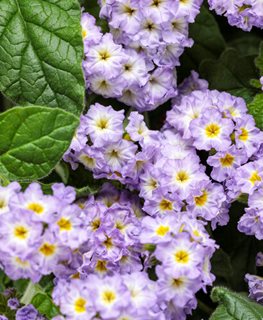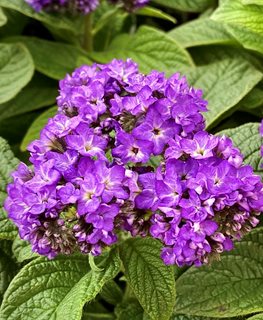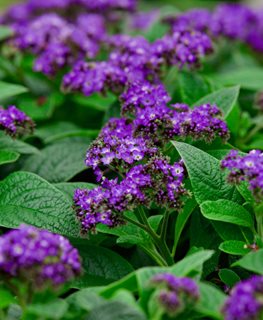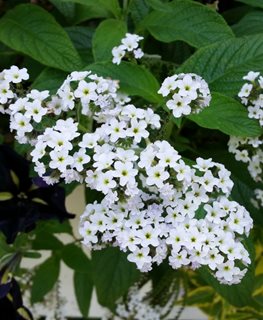HOW TO GROW HELIOTROPE FLOWERS IN YOUR GARDEN
This warm season flowering annual adds fragrance and color to the landscape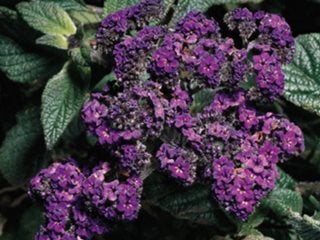
'Marine' heliotrope (Heliotropium arborescens). Photo: Proven Winners
Heliotrope is an old-fashioned summertime favorite, with colorful clusters of fragrant star-shaped flowers. Also known as cherry pie plant for the sweet cherry-like scent, the heliotrope flower is attractive to hummingbirds, butterflies, and other insect pollinators. “Heliotrope” means “to move with the sun,” in reference to the flowers that follow the light of the sun throughout the day.
The most commonly grown garden species (Heliotropium arborescens) is a tender perennial shrub in its native South American habit, but is most often grown as an annual. Heliotrope plants can be grown in containers, as edging, or massed as a bedding plant. Here’s how to grow and use heliotrope in your yard.
On this page: Basics | Planting | Care | Varieties | Propagation | Design Ideas
On this page:
- BASICS
- PLANTING HELIOTROPE
- HELIOTROPE CARE
- HELIOTROPE VARIETIES
- HOW TO PROPAGATE HELIOTROPE
- DESIGN IDEAS
BASICS
Botanical name:
Heliotropium spp.
Zones:
9-11, usually grown as an anual
Habit:
Compact bushy habit
Height/Spread:
When grown as an annual, plants typically reach 1 to 2 feet tall and wide. In frost-free climates, plants will remain perennial, reaching 1 to 4 feet tall and wide.
Exposure:
Full sun. For best bloom and vigorous growth, make sure plants receive at least 6 hours of direct sun. In hotter climates, provide light afternoon shade to protect the delicate flowers from becoming scorched.
Bloom time:
Summer to frost.
Flowers:
Clusters of small, star-shaped flowers 4 to 6 inches across occur in shades of purple, lavender, violet-blue, or white. Flowers have a sweet fragrance that is often compared to cherries, grapes, vanilla, or talcum powder.
Foliage:
Compact mounding plants produce 3- to 4-inch-long ovate leaves. The dark green foliage has tiny hairs, with a rough crinkled texture and distinct veining.
Is heliotrope deer resistant?
Deer are repelled by the fragrance of heliotrope flowers, as well as the rough texture of the leaves. However, nearly any plant may be susceptible to deer browsing if other food sources are scarce. (See more deer-resistant plants.)
PLANTING HELIOTROPE
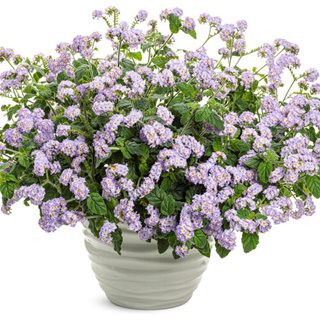
Augusta™ Lavender heliotrope. Photo: Proven Winners
When to plant:
Heliotrope is highly sensitive to cooler temperatures and frost. Make sure all danger of frost has passed in your region before planting outdoors. In temperatures below 40 degrees F, plants may experience damage or stunted growth, so it’s best to wait until temperatures are consistently warm.
Where to plant:
Choose a warm sunny site with rich, well-draining soil.
How to plant:
Loosen soil in planting area and lightly amend with compost or other organic matter. Make sure soil drains well. If plants are pot-bound, gently tease out the roots. Dig a hole slightly larger than the root ball and place in the planting hole so the top of the root ball is level with the surrounding soil. Fill in the hole with soil, tamp down gently to remove air pockets, and water thoroughly. Water plants regularly until established.
Soil:
Heliotrope prefers rich, well-draining soil with a pH between 6.5-7.5.
For containers:
Make sure pots have adequate drainage holes. Use a high quality all-purpose potting soil that drains well.
HELIOTROPE CARE
Temperature and humidity:
Heliotrope thrives in drier climates, with warm days and cooler nights. Too much heat can result in plant stress, while humid weather can make plants more prone to powdery mildew. Provide good air circulation to help prevent disease.
Watering:
Keep soil evenly moist but not soggy, and don’t allow plants to dry out. Overwatering can lead to root rot. Water early in the day and avoid getting foliage wet. Plants in containers will need more regular water than those in the ground, especially during hotter weather.
Amendments & fertilizer:
To perform its best, heliotrope should be fertilized regularly. For plants in the ground, fertilize monthly. Container-grown plants should be fertilized every two weeks. Use a fertilizer high in phosphorus to promote more blooms.
Pruning and deadheading:
After planting, pinch back stem tips to encourage more branching and a bushier habit. Deadhead spent flowers to promote rebloom.
Pests and diseases:
When planted in the right conditions, heliotrope has few pest or disease problems. Pests can include whiteflies, mealybugs, spider mites, and aphids. Diseases, which are due primary to overwatering or high humidity, include rust, powdery mildew, or leaf spot.
HELIOTROPE VARIETIES
PROPAGATING HELIOTROPE
Though most often grown from nursery starts, heliotrope can also be grown from seed or cuttings.
From seed:
Start seeds indoors 10 to 12 weeks before your last average frost date. Keep soil evenly moist, with temperatures between 70-75 degrees F. Allow 28 to 42 days for germination. Wait until the outdoor soil temperature has reached 60 degrees F before planting seedlings outside.
From cuttings:
Towards the end of the growing season, take stem cuttings to overwinter indoors. Cut a 5-inch section of a stem just below a leaf node. Remove flowers and lower leaves, dip the bottom end of the stem in rooting hormone and place in a sterile seed starting medium or mix of sand and perlite. Keep evenly watered in a warm environment until planting outdoors the following spring.
Note: It is illegal to propagate any patented or patent pending plants and sell them for monetary gain.
HELIOTROPE LANDSCAPING IDEAS

Photo by: Wirestock Creators / Shutterstock
For borders and landscapes: Use spreading varieties as bedding plants. Upright types can be planted in mixed borders or as pathway edging.
For slopes and hillsides: Mass spreading types along a slope or hillside in combination with other annuals for a quick burst of color all summer long.
For containers: Grow mounding or spreading types in containers, hanging baskets, or window boxes, by themselves or in combination with other warm season annuals.
There are many ways to incorporate heliotrope plants into your landscape. Here’s how:
- Plant in a bed or container alongside other flowering plants such as lantana, pentas, ageratum, alyssum, or zinnias to attract hummingbirds, butterflies, and other insect pollinators.
- Use to edge a pathway where you can regularly enjoy the color and fragrance.
- Grow heliotrope in a hanging basket and place on a porch, patio or deck where you can enjoy the sweetly scented, fragrant blooms up close.
- Combine in a container or sunny window box with warm season annuals for continuous color all summer long.
- Plant at the front of a mixed border in combination with other perennials and annuals with similar growing needs.
- Mass on a slope alongside other warm season plants for a quick burst of color.
- Place a hanging basket of heliotrope on a shepherd’s hook that you can move around the yard where a splash of color is needed.
Companion plants:
Heliotrope pairs well with many annuals as well as some perennials. Plant alongside other plants with similar growing needs such as African daisy (Osteospermum), Angelonia, black-eyed Susan (Rudbeckia hirta), floss flower (Ageratum), geranium (Geranium and Pelargonium), Lantana, licorice plant (Helichrysum), annual Lobelia, Calibrachoa, stock (Matthiola), or Salvia ‘Victoria’.
RELATED:
21 Low-Maintenance Plants
Annual Flowers
20 Drought-Tolerant Plants
24 Purple Flowers to Brighten Your Garden
Planting Ideas
